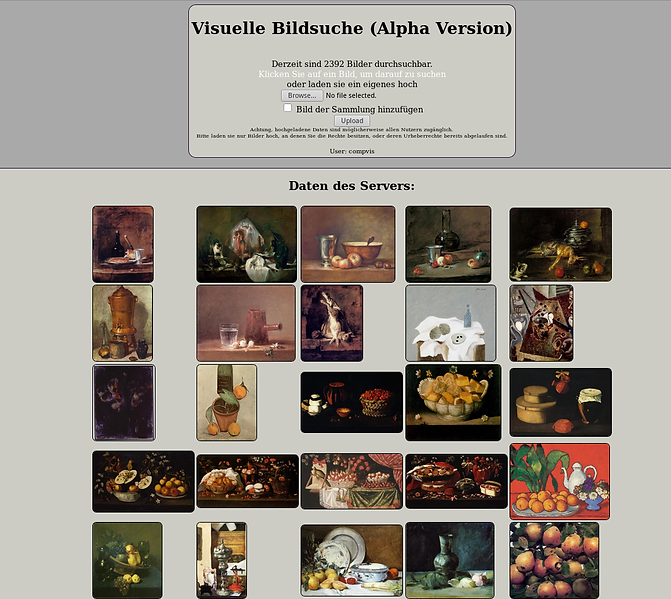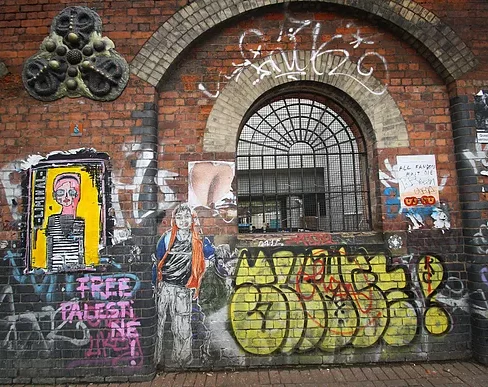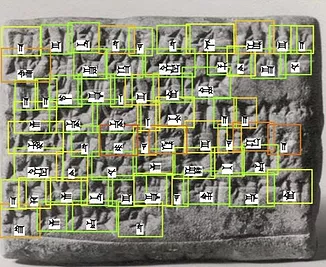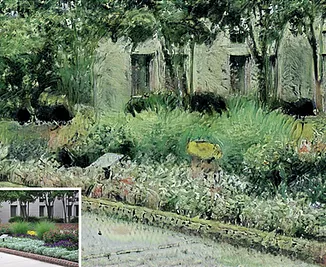From 2009 to 2020, an interdisciplinary project between computer vision and art history has been embedded within the Computer Vision group of Heidelberg University and is now being continued within the Machine Vision & Learning Group at Ludwig Maximilian University of Munich. Jointly, the group has carried out various tasks on diverse image corpora, including manuscripts, architectural drawings, religious artworks, or photographs, which have been enabled by, for example, an interactive interface developed by the group. Tasks are related to object detection, form analysis and iconography. This is of major use for art historians, since their work is concerned,
For example, with the iconography of the enthroned Madonna (see Holbein) and its depiction in the history of art or tries to find recurrences of objects and figures in various paintings, thereby addressing reception history. Did Bruegel repeatedly depict a figure or object in his famous Wimmelbilder? And do we find similar motifs in other works by different artists? Computer-based methods, as established by the group, assist with answering these questions.
The following sites provide an overview over past and present works, including interfaces, object detection, form analysis and iconography.
 Visual Search Tool |
 Object Detection |
 Form Analysis |
|
Iconography |
 Cuneiform Sign Detection |
 Neural Style Transfer |
Selected Publications
2022
Rombach, Robin; Blattmann, Andreas; Ommer, Björn
Text-Guided Synthesis of Artistic Images with Retrieval-Augmented Diffusion Models Conference
Proceedings of the European Conference on Computer Vision (ECCV) Workshop on Visart, 2022.
@conference{nokey,
title = {Text-Guided Synthesis of Artistic Images with Retrieval-Augmented Diffusion Models},
author = {Robin Rombach and Andreas Blattmann and Björn Ommer},
url = {https://arxiv.org/abs/2207.13038},
year = {2022},
date = {2022-01-01},
urldate = {2022-01-01},
booktitle = {Proceedings of the European Conference on Computer Vision (ECCV) Workshop on Visart},
keywords = {},
pubstate = {published},
tppubtype = {conference}
}
Wright, Matthias; Ommer, Björn
ArtFID: Quantitative Evaluation of Neural Style Transfer Conference
Proceedings of the German Conference on Pattern Recognition (GCPR '22) (Oral), 2022.
@conference{Wright2022,
title = {ArtFID: Quantitative Evaluation of Neural Style Transfer},
author = {Matthias Wright and Björn Ommer},
url = {https://github.com/matthias-wright/art-fid
https://arxiv.org/abs/2207.12280},
doi = {10.48550/arXiv.2207.12280},
year = {2022},
date = {2022-01-01},
urldate = {2022-01-01},
booktitle = {Proceedings of the German Conference on Pattern Recognition (GCPR '22) (Oral)},
keywords = {},
pubstate = {published},
tppubtype = {conference}
}
2021
Ufer, Nikolai; Simon, Max; Lang, Sabine; Ommer, Björn
Large-scale interactive retrieval in art collections using multi-style feature aggregation Journal Article
In: PLoS ONE, vol. 16, no. 11, 2021.
@article{nokey,
title = {Large-scale interactive retrieval in art collections using multi-style feature aggregation},
author = {Nikolai Ufer and Max Simon and Sabine Lang and Björn Ommer},
url = {https://compvis.github.io/visual-search/},
doi = {10.1371/journal.pone.0259718},
year = {2021},
date = {2021-11-24},
urldate = {2021-11-24},
journal = {PLoS ONE},
volume = { 16},
number = {11},
keywords = {},
pubstate = {published},
tppubtype = {article}
}
Lang, Sabine; Ommer, Björn
Transforming Information Into Knowledge: How Computational Methods Reshape Art History Journal Article
In: Digital Humanities Quaterly (DHQ), vol. 15, no. 3, 2021.
@article{Lang2021,
title = {Transforming Information Into Knowledge: How Computational Methods Reshape Art History},
author = {Sabine Lang and Björn Ommer},
url = {http://digitalhumanities.org/dhq/vol/15/3/000560/000560.html},
year = {2021},
date = {2021-10-17},
urldate = {2021-10-17},
journal = {Digital Humanities Quaterly (DHQ)},
volume = {15},
number = {3},
keywords = {},
pubstate = {published},
tppubtype = {article}
}
Kotovenko, Dmytro; Wright, Matthias; Heimbrecht, Arthur; Ommer, Björn
Rethinking Style Transfer: From Pixels to Parameterized Brushstrokes Conference
Proceedings of the IEEE Conference on Computer Vision and Pattern Recognition (CVPR), 2021.
@conference{7041,
title = {Rethinking Style Transfer: From Pixels to Parameterized Brushstrokes},
author = {Dmytro Kotovenko and Matthias Wright and Arthur Heimbrecht and Björn Ommer},
url = {https://compvis.github.io/brushstroke-parameterized-style-transfer/
https://arxiv.org/abs/2103.17185},
year = {2021},
date = {2021-01-01},
urldate = {2021-01-01},
booktitle = {Proceedings of the IEEE Conference on Computer Vision and Pattern Recognition (CVPR)},
abstract = {There have been many successful implementations of
neural style transfer in recent years. In most of these works,
the stylization process is confined to the pixel domain. How-
ever, we argue that this representation is unnatural because
paintings usually consist of brushstrokes rather than pixels.
We propose a method to stylize images by optimizing parameterized brushstrokes instead of pixels and further introduce
a simple differentiable rendering mechanism.
Our approach significantly improves visual quality and en-
ables additional control over the stylization process such as
controlling the flow of brushstrokes through user input.
We provide qualitative and quantitative evaluations that
show the efficacy of the proposed parameterized representation.},
keywords = {},
pubstate = {published},
tppubtype = {conference}
}
neural style transfer in recent years. In most of these works,
the stylization process is confined to the pixel domain. How-
ever, we argue that this representation is unnatural because
paintings usually consist of brushstrokes rather than pixels.
We propose a method to stylize images by optimizing parameterized brushstrokes instead of pixels and further introduce
a simple differentiable rendering mechanism.
Our approach significantly improves visual quality and en-
ables additional control over the stylization process such as
controlling the flow of brushstrokes through user input.
We provide qualitative and quantitative evaluations that
show the efficacy of the proposed parameterized representation.
2020
Lang, Sabine; Ommer, Björn
Das Objekt jenseits der Digitalisierung Conference
Das digitale Objekt, vol. 7, 2020, ISBN: 978-3-948808-00-6.
@conference{7038,
title = {Das Objekt jenseits der Digitalisierung},
author = {Sabine Lang and Björn Ommer},
url = {https://www.youtube.com/watch?v=QqupZYCTl98
https://www.deutsches-museum.de/assets/Verlag/Download/Studies/studies-7-download.pdf
},
isbn = {978-3-948808-00-6},
year = {2020},
date = {2020-01-01},
urldate = {2020-01-01},
booktitle = {Das digitale Objekt},
volume = {7},
abstract = {Der technische Fortschritt der letzten Jahrzehnte hat disruptive Veränderungen für Gesellschaft, Wirtschaft und Wissenschaft gebracht: Die Digitalisierung ist ein Resultat dessen und beeinflusst, wie wir auf Daten zugreifen, diese verarbeiten, analysieren und Ergebnisse verbreiten. Obwohl dadurch bereits ein Wandel eingeleitet worden ist, kann das Digitalisieren von Textdokumenten oder Bildern nicht das endgültige Ziel sein. Der Fokus aktueller Bestrebungen sollte vielmehr auf der Möglichkeit der Weiterverarbeitung von Digitalisaten liegen – dies schließt eine intelligente Informationsverarbeitung ein. Der Wert der Digitalisierung besteht nicht in der bloßen Anhäufung digitaler Sammlun- gen, sondern in der Tatsache, dass sie weitaus mehr ermöglicht als das Analoge und dafür die notwendigen Grundvoraussetzungen schafft.
Die Problematik besteht nun darin, dass die meisten Verarbeitungs- und Analyse- methoden für digitale Daten noch analog oder diesen nachempfunden sind: So werden digitale Sammlungen und darin enthaltene Bilder häufig noch mit den eigenen Augen, in traditionell komparativer Weise betrachtet und evaluiert. Dass dies aufgrund der Fülle an Daten nicht effizient ist, muss an dieser Stelle nicht betont werden. Obwohl das ana- loge und das digitale Bild den gleichen Inhalt zeigen können, haben beide doch ganz unterschiedliche Substrate. Ein Unterschied besteht zum Beispiel darin, dass digitale Bilder im Gegensatz zu analogen einfach manipuliert und dupliziert werden können. Das Digitale ist nicht das Analoge in neuer Form, und so bedarf es genuin digitaler Methoden für die Verarbeitung digitaler Daten. Durch die Entwicklung computerge- stützter Verfahren entstehen neue Möglichkeiten, Inhalte zu erschließen: Dazu gehören Ansätze zur Objektsuche oder das Gruppieren und Sortieren der Daten entsprechend benutzerdefinierter Dimensionen; dies schließt übergeordnete Kategorien wie Stil oder Genre, aber auch nuancierte Begriffe wie Alter oder Gewichtung der Bildkomposition ein. Doch das Digitale und entsprechende Verfahren können noch weitaus mehr leisten: Generative Verfahren, wie die Bildsynthese und Stilisierung eines Bildes, ermöglichen eine Blickänderung auf das Artefakt und schließlich die Modifizierung des Objekts selbst. Wie hätte ein Künstler eine uns sichtbare Szene gemalt und dargestellt? Und wie sieht ein Mensch in der Pose eines anderen aus? Dies sind Fragen, die durch die Anwendung com- putergestützter Methoden beantwortet werden können. Für das Museum haben diese Ansätze eine besondere Relevanz, da sie neue Arten des Betrachtens und Vermittelns von Kunstwerken oder zum Beispiel die Rekonstruktion verlorener Artefakte erlauben. In Zusammenarbeit von Mensch und Maschine entstehen so neue effektive Verfahren, die Inhalte erschließen, Verbindungen etablieren und neues Wissen generieren.},
keywords = {},
pubstate = {published},
tppubtype = {conference}
}
Die Problematik besteht nun darin, dass die meisten Verarbeitungs- und Analyse- methoden für digitale Daten noch analog oder diesen nachempfunden sind: So werden digitale Sammlungen und darin enthaltene Bilder häufig noch mit den eigenen Augen, in traditionell komparativer Weise betrachtet und evaluiert. Dass dies aufgrund der Fülle an Daten nicht effizient ist, muss an dieser Stelle nicht betont werden. Obwohl das ana- loge und das digitale Bild den gleichen Inhalt zeigen können, haben beide doch ganz unterschiedliche Substrate. Ein Unterschied besteht zum Beispiel darin, dass digitale Bilder im Gegensatz zu analogen einfach manipuliert und dupliziert werden können. Das Digitale ist nicht das Analoge in neuer Form, und so bedarf es genuin digitaler Methoden für die Verarbeitung digitaler Daten. Durch die Entwicklung computerge- stützter Verfahren entstehen neue Möglichkeiten, Inhalte zu erschließen: Dazu gehören Ansätze zur Objektsuche oder das Gruppieren und Sortieren der Daten entsprechend benutzerdefinierter Dimensionen; dies schließt übergeordnete Kategorien wie Stil oder Genre, aber auch nuancierte Begriffe wie Alter oder Gewichtung der Bildkomposition ein. Doch das Digitale und entsprechende Verfahren können noch weitaus mehr leisten: Generative Verfahren, wie die Bildsynthese und Stilisierung eines Bildes, ermöglichen eine Blickänderung auf das Artefakt und schließlich die Modifizierung des Objekts selbst. Wie hätte ein Künstler eine uns sichtbare Szene gemalt und dargestellt? Und wie sieht ein Mensch in der Pose eines anderen aus? Dies sind Fragen, die durch die Anwendung com- putergestützter Methoden beantwortet werden können. Für das Museum haben diese Ansätze eine besondere Relevanz, da sie neue Arten des Betrachtens und Vermittelns von Kunstwerken oder zum Beispiel die Rekonstruktion verlorener Artefakte erlauben. In Zusammenarbeit von Mensch und Maschine entstehen so neue effektive Verfahren, die Inhalte erschließen, Verbindungen etablieren und neues Wissen generieren.
Dencker, Tobias; Klinkisch, Pablo; Maul, Stefan M; Ommer, Björn
Deep learning of cuneiform sign detection with weak supervision using transliteration alignment Journal Article
In: PLoS ONE, vol. 15, 2020.
@article{7029,
title = {Deep learning of cuneiform sign detection with weak supervision using transliteration alignment},
author = {Tobias Dencker and Pablo Klinkisch and Stefan M Maul and Björn Ommer},
url = {https://hci.iwr.uni-heidelberg.de/compvis/projects/cuneiform
https://ommer-lab.com/wp-content/uploads/2021/10/Deep-Learning-of-Cuneiform-Sign-Detection-with-Weak-Supervivion-Using-Transliteration-Alignment.pdf
},
doi = {https://doi.org/10.1371/journal.pone.0243039},
year = {2020},
date = {2020-01-01},
urldate = {2020-01-01},
journal = {PLoS ONE},
volume = {15},
chapter = {1-21},
abstract = {The cuneiform script provides a glimpse into our ancient history. However, reading age-old clay tablets is time-consuming and requires years of training. To simplify this process, we propose a deep-learning based sign detector that locates and classifies cuneiform signs in images of clay tablets. Deep learning requires large amounts of training data in the form of bounding boxes around cuneiform signs, which are not readily available and costly to obtain in the case of cuneiform script. To tackle this problem, we make use of existing transliterations, a sign-by-sign representation of the tablet content in Latin script. Since these do not provide sign localization, we propose a weakly supervised approach: We align tablet images with their corresponding transliterations to localize the transliterated signs in the tablet image, before using these localized signs in place of annotations to re-train the sign detector. A better sign detector in turn boosts the quality of the alignments. We combine these steps in an iterative process that enables training a cuneiform sign detector from transliterations only. While our method works weakly supervised, a small number of annotations further boost the performance of the cuneiform sign detector which we evaluate on a large collection of clay tablets from the Neo-Assyrian period. To enable experts to directly apply the sign detector in their study of cuneiform texts, we additionally provide a web application for the analysis of clay tablets with a trained cuneiform sign detector.},
keywords = {},
pubstate = {published},
tppubtype = {article}
}
Ufer, Nikolai; Lang, Sabine; Ommer, Björn
IEEE European Conference on Computer Vision (ECCV), VISART Workshop , 2020.
@conference{7064,
title = {Object Retrieval and Localization in Large Art Collections Using Deep Multi-style Feature Fusion and Iterative Voting},
author = {Nikolai Ufer and Sabine Lang and Björn Ommer},
url = {https://arxiv.org/abs/2107.06935
},
doi = {https://doi.org/10.1007/978-3-030-66096-3_12},
year = {2020},
date = {2020-01-01},
urldate = {2020-01-01},
booktitle = {IEEE European Conference on Computer Vision (ECCV), VISART Workshop },
abstract = {The search for specific objects or motifs is essential to art history as both assist in decoding the meaning of artworks. Digitization has produced large art collections, but manual methods prove to be insufficient to analyze them. In the following, we introduce an algorithm that allows users to search for image regions containing specific motifs or objects and find similar regions in an extensive dataset, helping art historians to analyze large digitized art collections. Computer vision has presented efficient methods for visual instance retrieval across photographs. However, applied to art collections, they reveal severe deficiencies because of diverse motifs and massive domain shifts induced by differences in techniques, materials, and styles. In this paper, we present a multi-style feature fusion approach that successfully reduces the domain gap and improves retrieval results without labelled data or curated image collections. Our region-based voting with GPU-accelerated approximate nearest-neighbour search allows us to find and localize even small motifs within an extensive dataset in a few seconds. We obtain state-of-the-art results on the Brueghel dataset and demonstrate its generalization to inhomogeneous collections with a large number of distractors.},
keywords = {},
pubstate = {published},
tppubtype = {conference}
}
2019
Ufer, Nikolai; Lui, Kam To; Schwarz, Katja; Warkentin, Paul; Ommer, Björn
Weakly Supervised Learning of Dense SemanticCorrespondences and Segmentation Conference
German Conference on Pattern Recognition (GCPR), 2019.
@conference{6324,
title = {Weakly Supervised Learning of Dense SemanticCorrespondences and Segmentation},
author = {Nikolai Ufer and Kam To Lui and Katja Schwarz and Paul Warkentin and Björn Ommer},
url = {https://www.researchgate.net/publication/336816354_Weakly_Supervised_Learning_of_Dense_Semantic_Correspondences_and_Segmentation},
doi = {10.1007/978-3-030-33676-9_32},
year = {2019},
date = {2019-01-01},
urldate = {2019-01-01},
booktitle = {German Conference on Pattern Recognition (GCPR)},
keywords = {},
pubstate = {published},
tppubtype = {conference}
}
Kotovenko, Dmytro; Sanakoyeu, Artsiom; Lang, Sabine; Ommer, Björn
Content and Style Disentanglement for Artistic Style Transfer Conference
Proceedings of the Intl. Conf. on Computer Vision (ICCV), 2019.
@conference{6322,
title = {Content and Style Disentanglement for Artistic Style Transfer},
author = {Dmytro Kotovenko and Artsiom Sanakoyeu and Sabine Lang and Björn Ommer},
url = {https://compvis.github.io/content-style-disentangled-ST/
https://compvis.github.io/content-style-disentangled-ST/paper.pdf},
year = {2019},
date = {2019-01-01},
urldate = {2019-01-01},
booktitle = {Proceedings of the Intl. Conf. on Computer Vision (ICCV)},
keywords = {},
pubstate = {published},
tppubtype = {conference}
}
Kotovenko, Dmytro; Sanakoyeu, A.; Lang, Sabine; Ma, P.; Ommer, Björn
Using a Transformation Content Block For Image Style Transfer Conference
Proceedings of the IEEE Conference on Computer Vision and Pattern Recognition (CVPR), 2019.
@conference{6300,
title = {Using a Transformation Content Block For Image Style Transfer},
author = {Dmytro Kotovenko and A. Sanakoyeu and Sabine Lang and P. Ma and Björn Ommer},
url = {https://compvis.github.io/content-targeted-style-transfer/
https://arxiv.org/abs/2003.08407},
year = {2019},
date = {2019-01-01},
urldate = {2019-01-01},
booktitle = {Proceedings of the IEEE Conference on Computer Vision and Pattern Recognition (CVPR)},
keywords = {},
pubstate = {published},
tppubtype = {conference}
}
2018
Sanakoyeu, A.; Kotovenko, Dmytro; Lang, Sabine; Ommer, Björn
A Style-Aware Content Loss for Real-time HD Style Transfer Conference
Proceedings of the European Conference on Computer Vision (ECCV) (Oral), 2018.
@conference{style_aware_content_loss_eccv18,
title = {A Style-Aware Content Loss for Real-time HD Style Transfer},
author = {A. Sanakoyeu and Dmytro Kotovenko and Sabine Lang and Björn Ommer},
url = {https://compvis.github.io/adaptive-style-transfer/
https://arxiv.org/abs/1807.10201},
year = {2018},
date = {2018-01-01},
urldate = {2018-01-01},
booktitle = {Proceedings of the European Conference on Computer Vision (ECCV) (Oral)},
abstract = {Recently, style transfer has received a lot of attention. While much of this research has aimed at speeding up processing, the approaches are still lacking from a principled, art historical standpoint: a style is more than just a single image or an artist, but previous work is limited to only a single instance of a style or shows no benefit from more images. Moreover, previous work has relied on a direct comparison of art in the domain of RGB images or on CNNs pre-trained on ImageNet, which requires millions of labeled object bounding boxes and can introduce an extra bias, since it has been assembled without artistic consideration. To circumvent these issues, we propose a style-aware content loss, which is trained jointly with a deep encoder-decoder network for real-time, high-resolution stylization of images and videos. We propose a quantitative measure for evaluating the quality of a stylized image and also have art historians rank patches from our approach against those from previous work. These and our qualitative results ranging from small image patches to megapixel stylistic images and videos show that our approach better captures the subtle nature in which a style affects content.},
keywords = {},
pubstate = {published},
tppubtype = {conference}
}
Lang, Sabine; Ommer, Björn
Reconstructing Histories: Analyzing Exhibition Photographs with Computational Methods Journal Article
In: Arts, Computational Aesthetics, vol. 7, 64, 2018.
@article{6283,
title = {Reconstructing Histories: Analyzing Exhibition Photographs with Computational Methods},
author = {Sabine Lang and Björn Ommer},
url = {https://ommer-lab.com/wp-content/uploads/2021/10/Reconstructing-Histories_Analyzing-Exhibition-Photograhs-wit-Computational-Methods.pdf
},
year = {2018},
date = {2018-01-01},
urldate = {2018-01-01},
journal = {Arts, Computational Aesthetics},
volume = {7, 64},
chapter = {1-21},
keywords = {},
pubstate = {published},
tppubtype = {article}
}
Lang, Sabine; Ommer, Björn
Attesting Similarity: Supporting the Organization and Study of Art Image Collections with Computer Vision Journal Article
In: Digital Scholarship in the Humanities, Oxford University Press, vol. 33, no. 4, pp. 845-856, 2018.
@article{6247,
title = {Attesting Similarity: Supporting the Organization and Study of Art Image Collections with Computer Vision},
author = {Sabine Lang and Björn Ommer},
url = {https://doi.org/10.1093/llc/fqy006
https://hci.iwr.uni-heidelberg.de/compvis/projects/digihum
https://academic.oup.com/dsh/article/33/4/845/4964861?guestAccessKey=3eeea652-0c2b-4272-9e42-5ef4c5af6cc4},
year = {2018},
date = {2018-01-01},
urldate = {2018-01-01},
journal = {Digital Scholarship in the Humanities, Oxford University Press},
volume = {33},
number = {4},
pages = {845-856},
keywords = {},
pubstate = {published},
tppubtype = {article}
}
Bell, P.; Ommer, Björn
Computer Vision und Kunstgeschichte — Dialog zweier Bildwissenschaften Book Chapter
In: Computing Art Reader: Einführung in die digitale Kunstgeschichte, P. Kuroczyński et al. (ed.), 2018.
@inbook{6287,
title = {Computer Vision und Kunstgeschichte — Dialog zweier Bildwissenschaften},
author = {P. Bell and Björn Ommer},
url = {https://hci.iwr.uni-heidelberg.de/sites/default/files/publications/files/1523349512/413-17-83318-2-10-20181210.pdf},
year = {2018},
date = {2018-01-01},
urldate = {2018-01-01},
booktitle = {Computing Art Reader: Einführung in die digitale Kunstgeschichte, P. Kuroczyński et al. (ed.)},
keywords = {},
pubstate = {published},
tppubtype = {inbook}
}
2014
Monroy, A.; Bell, P.; Ommer, Björn
Morphological Analysis for Investigating Artistic Images Journal Article
In: Image and Vision Computing, vol. 32, no. 6, pp. 414-423, 2014.
@article{monoroy:IVC:2014,
title = {Morphological Analysis for Investigating Artistic Images},
author = {A. Monroy and P. Bell and Björn Ommer},
url = {https://hci.iwr.uni-heidelberg.de/compvis/projects/digihum
https://ommer-lab.com/wp-content/uploads/2021/10/Morphological-Analysis-for-investigating-artistic-images.pdf},
year = {2014},
date = {2014-01-01},
urldate = {2014-01-01},
journal = {Image and Vision Computing},
volume = {32},
number = {6},
pages = {414-423},
publisher = {Elsevier},
keywords = {},
pubstate = {published},
tppubtype = {article}
}
Takami, M.; Bell, P.; Ommer, Björn
An Approach to Large Scale Interactive Retrieval of Cultural Heritage Conference
Eurographics Workshop on Graphics and Cultural Heritage, The Eurographics Association, 2014.
@conference{takami:GCH:2014,
title = {An Approach to Large Scale Interactive Retrieval of Cultural Heritage},
author = {M. Takami and P. Bell and Björn Ommer},
url = {https://hci.iwr.uni-heidelberg.de/compvis/projects/digihum
https://ommer-lab.com/wp-content/uploads/2021/10/An-Approach-to-Large-Scale-Interactive-Retrieval-of-Cultural-Heritage.pdf},
year = {2014},
date = {2014-01-01},
urldate = {2014-01-01},
booktitle = {Eurographics Workshop on Graphics and Cultural Heritage},
publisher = {The Eurographics Association},
keywords = {},
pubstate = {published},
tppubtype = {conference}
}
2012
Monroy, A.; Bell, P.; Ommer, Björn
Shaping Art with Art: Morphological Analysis for Investigating Artistic Reproductions Conference
Proceedings of the European Conference on Computer Vision, Workshop on VISART, vol. 7583, Springer, 2012.
@conference{monroy:ECCV:2012,
title = {Shaping Art with Art: Morphological Analysis for Investigating Artistic Reproductions},
author = {A. Monroy and P. Bell and Björn Ommer},
url = {https://hci.iwr.uni-heidelberg.de/compvis/projects/digihum
https://ommer-lab.com/wp-content/uploads/2021/10/Shaping-Art-with-Art_Morphological-Analysis-for-Investigating-Artistic-Reproductions.pdf},
year = {2012},
date = {2012-01-01},
urldate = {2012-01-01},
booktitle = {Proceedings of the European Conference on Computer Vision, Workshop on VISART},
volume = {7583},
pages = {571--580},
publisher = {Springer},
keywords = {},
pubstate = {published},
tppubtype = {conference}
}
2011
Monroy, A.; Carque, Bernd; Ommer, Björn
Reconstructing the Drawing Process of Reproductions from Medieval Images Conference
Proceedings of the International Conference on Image Processing, IEEE, 2011.
@conference{monroy:ICIP:2011,
title = {Reconstructing the Drawing Process of Reproductions from Medieval Images},
author = {A. Monroy and Bernd Carque and Björn Ommer},
url = {https://hci.iwr.uni-heidelberg.de/content/reconstructing-drawing-process-reproductions-medieval-images
https://ommer-lab.com/wp-content/uploads/2021/10/Reconstructing-the-Drawing-Process-of-Reproductions-from-Medieval-Images.pdf
},
year = {2011},
date = {2011-01-01},
urldate = {2011-01-01},
booktitle = {Proceedings of the International Conference on Image Processing},
pages = {2974--2977},
publisher = {IEEE},
keywords = {},
pubstate = {published},
tppubtype = {conference}
}
Schlecht, J.; Ommer, Björn
Contour-based Object Detection Conference
BMVC, 2011.
@conference{schlecht:BMVC:2011,
title = {Contour-based Object Detection},
author = {J. Schlecht and Björn Ommer},
url = {https://hci.iwr.uni-heidelberg.de/content/contour-based-object-detection
https://ommer-lab.com/wp-content/uploads/2021/10/Contour-based-Object-Detection.pdf},
year = {2011},
date = {2011-01-01},
urldate = {2011-01-01},
booktitle = {BMVC},
pages = {1--9},
keywords = {},
pubstate = {published},
tppubtype = {conference}
}
Schlecht, J.; Carque, Bernd; Ommer, Björn
Detecting Gestures in Medieval Images Conference
Proceedings of the International Conference on Image Processing, IEEE, 2011.
@conference{schlecht:ICIP:2011,
title = {Detecting Gestures in Medieval Images},
author = {J. Schlecht and Bernd Carque and Björn Ommer},
url = {https://hci.iwr.uni-heidelberg.de/compvis/projects/digihum
https://ommer-lab.com/wp-content/uploads/2021/10/Detecting-Gestures-in-Medieval-Images.pdf},
year = {2011},
date = {2011-01-01},
urldate = {2011-01-01},
booktitle = {Proceedings of the International Conference on Image Processing},
pages = {1309--1312},
publisher = {IEEE},
keywords = {},
pubstate = {published},
tppubtype = {conference}
}
Monroy, A.; Kröger, Thorben; Arnold, M.; Ommer, Björn
Parametric Object Detection for Iconographic Analysis Conference
Scientific Computing & Cultural Heritage, 2011.
@conference{monroy:SCCH:2011,
title = {Parametric Object Detection for Iconographic Analysis},
author = {A. Monroy and Thorben Kröger and M. Arnold and Björn Ommer},
url = {https://hci.iwr.uni-heidelberg.de/compvis/projects/digihum
http://www.academia.edu/9439693/Parametric_Object_Detection_for_Iconographic_Analysis},
year = {2011},
date = {2011-01-01},
urldate = {2011-01-01},
booktitle = {Scientific Computing & Cultural Heritage},
keywords = {},
pubstate = {published},
tppubtype = {conference}
}
